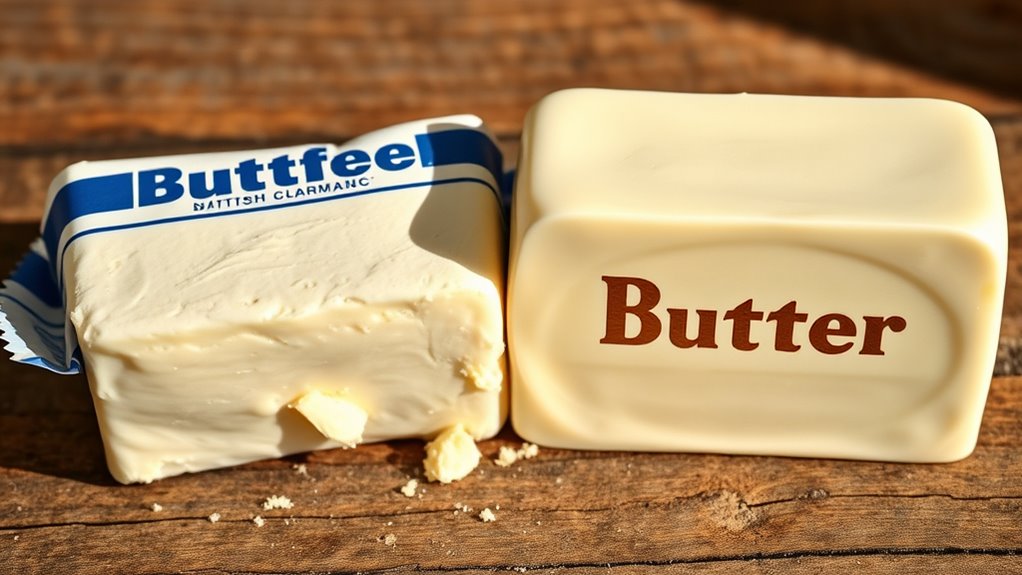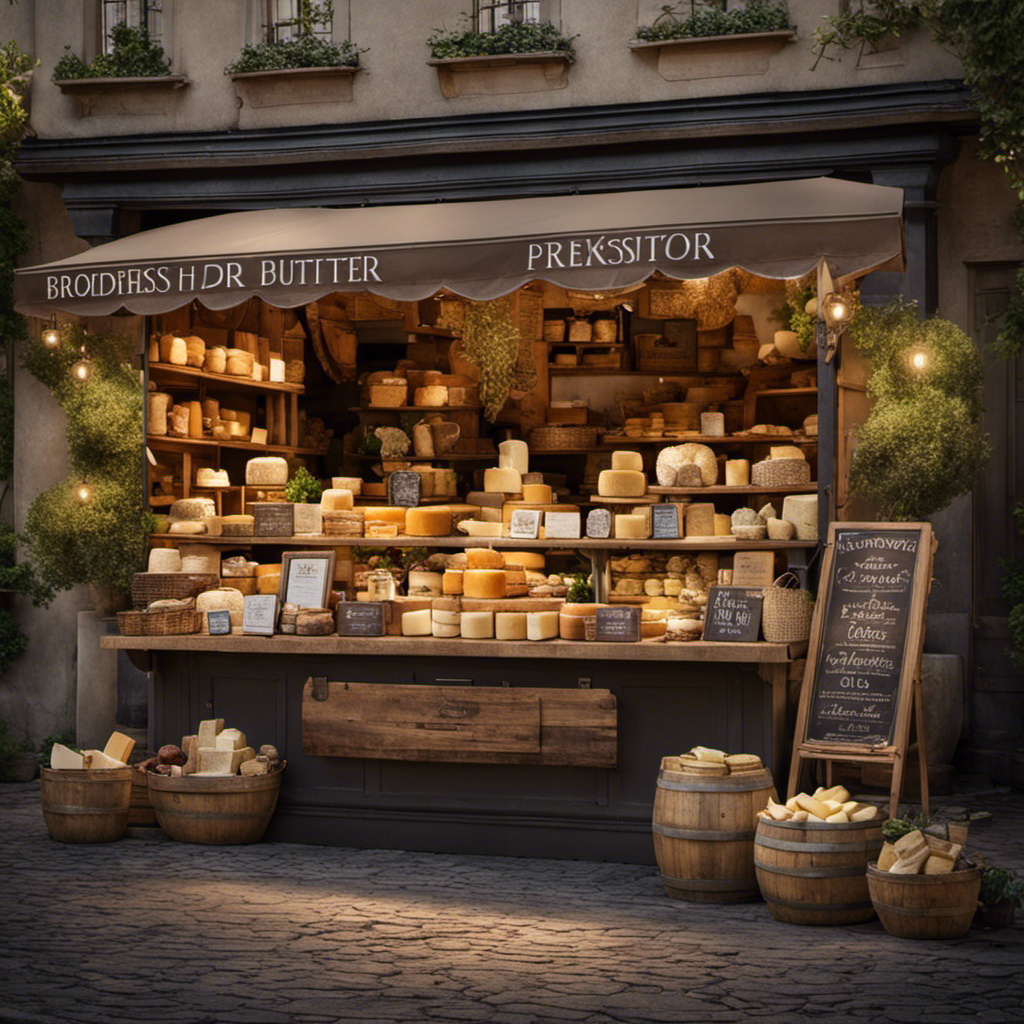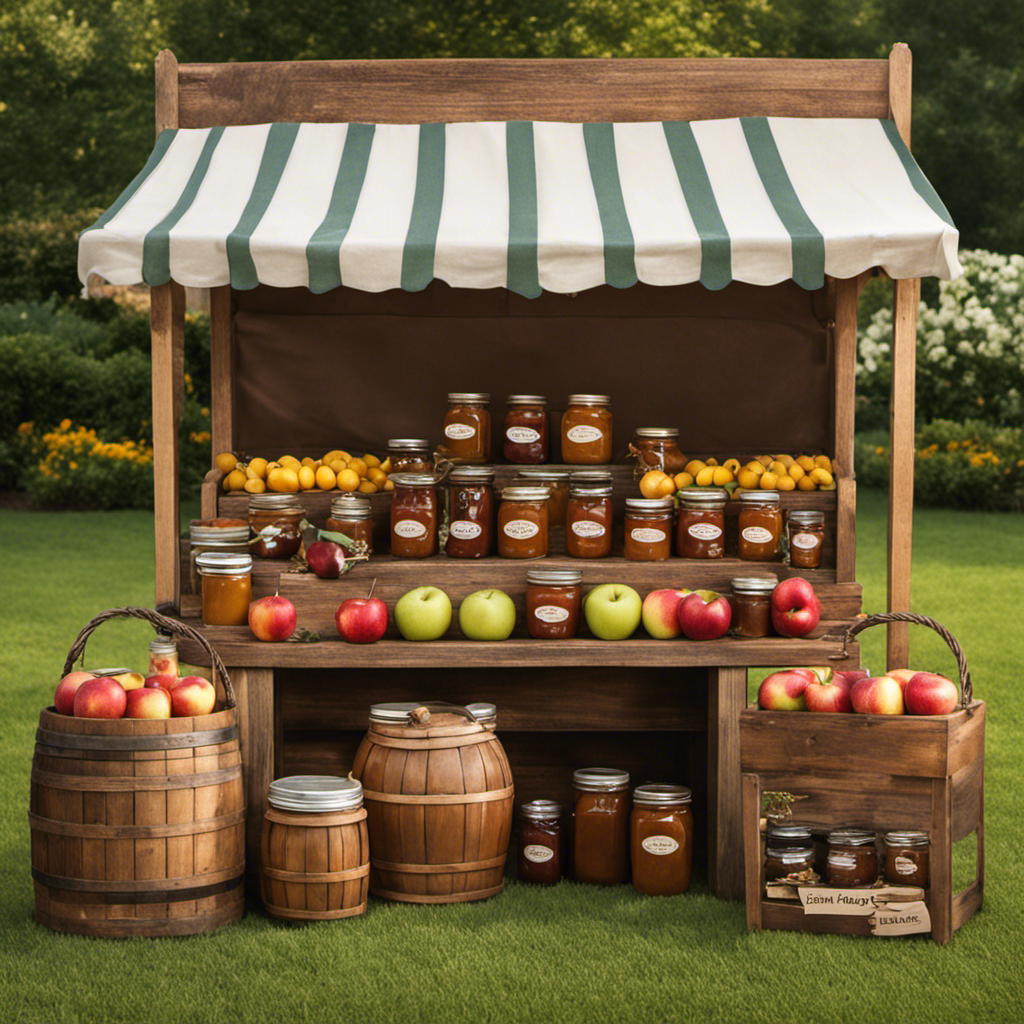Blind taste tests show many consumers can’t tell the difference between store-brand and name-brand butter, as flavor, texture, and aroma often match closely. Brand perception and price influence opinions more than actual taste quality. Studies indicate that you might find store brands to be just as good, or even better, than pricier options. Want to discover how these insights can change your shopping habits? Keep exploring for more details.
Key Takeaways
- Blind taste tests often show consumers cannot reliably distinguish between store-brand and name-brand butter.
- Studies indicate similar flavor, texture, and aroma profiles across store and name brands in blind evaluations.
- Many participants prefer store brands or find no significant difference when brand bias is eliminated.
- Price differences do not necessarily correlate with perceived quality in blind taste comparisons.
- Blind taste statistics highlight that store-brand butters can match or surpass name brands in sensory quality.
The Purpose Behind Taste Testing

Taste testing serves a crucial role in helping consumers determine which butter they prefer, especially when comparing store-brand options to name brands. It helps you set aside preconceived notions and challenge consumer bias that might influence your choices. By focusing on taste perception, you can objectively evaluate the flavor, texture, and overall quality of each butter without assumptions about brand reputation. This process ensures that your preferences are based on actual sensory experience rather than brand loyalty or marketing influence. Conducting blind taste tests allows you to make more informed decisions, ultimately discovering whether store-brand options can match or even surpass the quality of name brands. In this way, taste testing becomes a reliable tool for unbiased, genuine evaluation. Additionally, understanding the horsepower of electric dirt bikes can be useful for comparing performance qualities in different product categories.
Methodology of the Blind Tests

To accurately compare store-brand and name-brand butters, it’s important to follow a consistent and unbiased testing process. You should use blind testing to eliminate brand influence, ensuring participants judge only the taste. Carefully selecting samples is essential; choose a variety of brands and batches to reflect typical market options. Randomize the order of samples to prevent bias from order effects. Keep serving conditions uniform—same temperature, portion size, and presentation—to guarantee fairness. Provide clear instructions, emphasizing that participants should focus solely on flavor, texture, and aroma. Additionally, understanding the importance of color accuracy can help ensure that the visual presentation of samples is consistent and true to life, which influences perceived quality. By maintaining strict control over sample selection and test conditions, you can gather reliable data that genuinely compares the taste qualities of store-brand versus name-brand butters.
Demographic Insights and Participant Profiles

Understanding the demographic makeup of participants is crucial for interpreting the results of blind butter tests. Variations in age, gender, and cultural backgrounds can influence taste perceptions and preferences. Participant diversity ensures that the findings reflect a broad spectrum of consumer experiences, reducing bias. In our study, we included individuals from different demographic groups, highlighting the importance of demographic variations in taste testing. Recognizing this diversity helps contextualize the results, as preferences might differ across age groups or cultural backgrounds. Additionally, demographic insights can reveal how factors like skin type or lifestyle influence taste and perception, offering a more comprehensive understanding of consumer behavior in taste tests. By profiling participants accurately, we gain insights into how demographic factors shape butter preferences, making our conclusions more reliable and applicable to a wider audience. This approach underscores the significance of demographic insights in understanding consumer behavior in taste tests.
Overall Results and Consumer Preferences

You’ll notice clear preference trends emerge from the taste test outcomes, showing which brands consumers favor. Many participants couldn’t tell the difference between store-brand and name-brand butter in blind tastings. These results highlight how taste and perception influence consumer choices more than brand names.
Preference Trends Revealed
Recent surveys reveal clear trends in consumer preferences when it comes to store-brand versus name-brand butter. Many shoppers show fluctuating brand loyalty, often switching based on price or perceived quality. Consumer skepticism influences choices, leading some to doubt claims of superior taste or value. Key insights include:
- A significant portion of consumers prefer store-brands for everyday use due to affordability.
- Brand loyalty remains strong among those who trust specific labels for quality consistency.
- Skeptics tend to test store-brands repeatedly, expecting better deals but remaining cautious about taste and ingredients.
- The influence of sustainability practices in branding can also sway consumer preferences, especially among environmentally conscious shoppers.
These trends highlight that preferences aren’t solely about taste but are shaped by trust and perceptions of value. Understanding these factors can help brands tailor strategies to either build loyalty or address skepticism effectively.
Taste Test Outcomes
Taste test outcomes reveal that, overall, consumers find little difference between store-brand and name-brand butter in flavor and texture. This suggests that butter branding has minimal impact on consumer perception when it comes to taste. Participants in blind tastings couldn’t reliably distinguish between the two, indicating that quality perceptions are often influenced more by packaging and branding than actual flavor. The results challenge the assumption that name-brand butter is inherently superior, showing that store brands can match or even exceed expectations. These findings highlight that consumers may prioritize price and value over brand loyalty when it comes to butter. Ultimately, the taste test outcomes demonstrate that, in a blind context, butter branding plays a smaller role in consumer preferences than many might assume. Additionally, understanding the role of attention in taste testing can help explain why consumers might not notice subtle differences during blind tastings.
Sensory Factors Influencing Ratings

Your perception of butter often hinges on sensory factors like flavor, texture, and aroma. You might notice subtle differences in taste or how smooth and consistent each brand feels. These qualities can profoundly influence your overall rating and preference.
Flavor Profile Differences
Have you ever noticed how store-brand and name-brand butters can differ in flavor despite similar ingredients? These differences often hinge on subtle factors like flavor profile and how butter melts on your palate. When tasting, consider that:
- The melting point influences flavor release, with a smoother melt often enhancing flavor intensity.
- Variations in cream sourcing can create distinct flavor notes, affecting overall perception.
- Small adjustments in processing can amplify or mellow certain tastes, impacting your rating.
- The melting behavior of butter affects how quickly flavors are released and perceived during tasting, further influencing your overall impression.
You might find that a name-brand butter offers a richer flavor intensity, lingering longer, while store brands may have a milder, less pronounced profile. These sensory differences shape your overall experience, even if ingredients seem alike.
Texture and Consistency
While flavor plays a significant role in your butter experience, texture and consistency also heavily influence your overall perception. When you spread butter, ease of spreadability is key; a butter with good spreadability ensures a smooth, even layer without tearing or crumbling. The way butter melts in your mouth also impacts your satisfaction—ideally, it should melt quickly and evenly, creating a creamy sensation. Variations in texture, such as firmness or graininess, can make a difference in how much you enjoy your toast or baked goods. Store-brand butters often have slightly different melting points and spreadability qualities compared to name brands, which may influence your preference. Paying attention to these sensory factors helps you choose butter that feels just right during your daily use. Additionally, the type of headphone jack used in your audio setup can affect your listening experience, just as texture influences your enjoyment of butter.
Aroma and Freshness
Aroma and freshness are essential sensory factors that can markedly influence your perception of butter quality. When evaluating butter, consider how its aroma reflects freshness—rancid or stale scents signal lower quality. Packaging plays a role here; well-sealed butter maintains aroma better, preserving freshness over time. Brand loyalty often influences your expectations of aroma, but blind tastings reveal that store brands can match or surpass name brands in scent quality. To understand aroma and freshness better, keep in mind:
- Strong, clean aroma indicates fresh butter.
- Butter packaging that minimizes air exposure maintains aroma longer.
- Recognizing subtle differences can challenge your brand loyalty assumptions.
- Sensory perception can be influenced by various factors, including individual expectations and environmental conditions.
Focusing on these factors helps you make more informed choices, regardless of whether it’s a store or name brand.
Price Versus Perceived Quality

Price often influences how you perceive the quality of butter, with many consumers assuming that higher-cost options are better. If you’re brand loyal, you might be willing to pay more, believing it guarantees superior taste or texture. However, price sensitivity varies among shoppers; some prioritize affordability over brand reputation. Studies show that many consumers struggle to distinguish between store brands and name brands in blind taste tests, despite paying different prices. This suggests that perceived quality is often linked more to branding and price cues than actual taste. You might find yourself trusting a familiar name or paying a premium, but the reality is that value isn’t always tied to cost. Recognizing this helps you make more informed choices based on quality rather than just price. Additionally, perceived quality can be influenced by factors beyond taste, such as packaging and marketing, further complicating the relationship between cost and actual product superiority.
Common Misconceptions About Store Brands

Many shoppers assume that store brands are inherently lower in quality or simply mimic their name-brand counterparts without offering real value. This myth correction reveals that store brands often match or surpass name-brand quality, especially in blind taste tests. Keep in mind these points:
- Store brands can provide better value without sacrificing quality.
- Brand loyalty doesn’t always reflect superior taste or ingredients.
- Many consumers are surprised to find store brands taste just as good, if not better.
Believing these misconceptions limits your options and may cause you to overlook quality products. Recognizing that store brands are a smart choice can lead to better savings without compromising your standards. Ultimately, it’s about making informed decisions, not assumptions.
Implications for Shoppers and Retailers

Understanding the true value of store-brand products has significant implications for both shoppers and retailers. If you perceive store brands as inferior, you might overlook savings without testing quality. Conversely, recognizing comparable taste can boost your brand loyalty and lead to smarter shopping choices. Retailers should focus on shaping positive consumer perception by highlighting quality and affordability. For instance, promoting regional flavors and traditions can enhance the appeal of store brands and foster trust among consumers.
Frequently Asked Questions
How Do Regional Store Brands Compare to National Brands in Taste?
You might notice regional taste preferences influence your view of store brands compared to national brands. Many shoppers find that local store brands match or even surpass national brands in taste, fostering strong store brand loyalty. Personal experiences vary, but regional differences often shape preferences. When comparing, consider that regional store brands can deliver quality that aligns with local tastes, making them a competitive choice for consumers seeking both value and flavor.
Do Flavor Preferences Vary Significantly Across Different Age Groups?
You might think flavor preferences stay steady across ages, but they actually vary quite a bit. Younger people often prefer bold, adventurous tastes, while older age groups lean toward familiar, subtle flavors. Age group preferences influence flavor variation, making taste tests fascinating. Your own preferences could shift as you grow older, highlighting how dynamic and personal flavor choices really are. So, yes, flavor preferences do change markedly across different age groups.
What Role Does Packaging Influence Consumer Perception of Butter Quality?
You might find that packaging perception greatly influences how you view butter quality. Visual appeal catches your eye and can suggest freshness or premium quality, even before you taste it. Bright, attractive packaging might make you believe the butter is better, while dull or plain designs could lead you to doubt its quality. Ultimately, your perception of butter’s quality often hinges on packaging and its visual appeal, shaping your buying choices.
Are There Specific Types of Recipes Where Brand Matters More?
When it comes to recipes, you’re really on the fence, but some dishes demand the real deal. For baking sensitivities and artisan variations, brand matters more because quality influences taste and texture. For delicate pastries or high-end desserts, using a trusted name guarantees consistency. In these cases, it’s better to play it safe than to risk a flop. Sometimes, you just have to stick to what’s proven to get the job done right.
How Do Environmental and Ethical Factors Impact Consumer Choices?
You’re influenced by environmental and ethical factors when choosing products. Sustainable sourcing appeals to your desire for responsible consumption, making you more likely to pick brands committed to eco-friendly practices. Ethical branding also matters, as it aligns with your values around animal welfare and fair labor. These factors often outweigh price or taste, guiding you to support companies that prioritize sustainability and ethics, shaping your overall purchasing decisions.
Conclusion
Remember, don’t judge a book by its cover—or a butter by its label. The blind taste tests show that store brands often match or even surpass name brands in flavor and quality. So, next time you’re shopping, trust your taste buds over assumptions. As the saying goes, “Don’t judge a book by its cover.” Give store brands a chance—you might just find a new favorite without breaking the bank.










